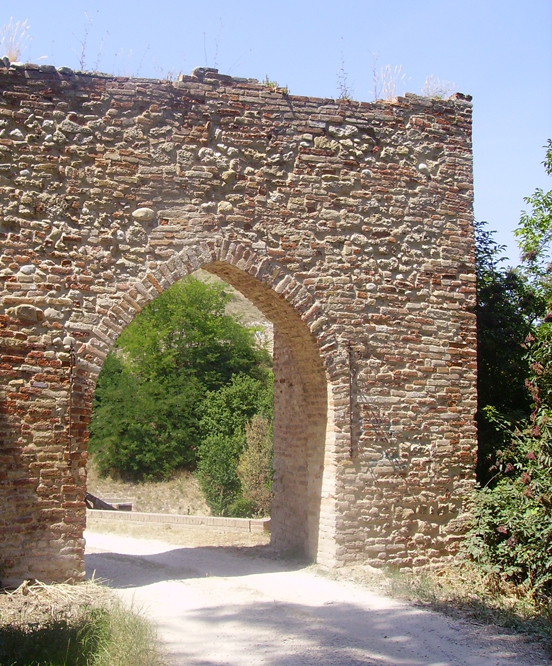Porta Cuprense
Le mura ed i torrioni di difesa di Ripatransone, innalzati quasi certamente dopo il 1205, anno di “nascita” del libero Comune, erano fatiscenti dopo l’assalto delle truppe di Francesco Sforza del 1444. Per interessamento del ripano Francesco Lunerti, il papa Eugenio IV accordò a Ripatransone l’esenzione trentennale dalle tasse per renderne possibile la ricostruzione. Altri aiuti furono concessi da Giosia d’Acquaviva, Duca d’Atri, che aveva legami di sangue e di affetto con la città.
Sottoposte nel corso dei secoli a diversi interventi, le mura medievali hanno subito gravi danni negli anni 1966-67 per l’ampliamento della strada provinciale “Cuprense”. Ciò nonostante, quella di Ripatransone resta una delle cinte fortificate marchigiane più belle e articolate. Lo sviluppo del perimetro murario in un’incisione ottocentesca è stimato in metri 2.418; esso segue l’orografia del sito, che varia da quartiere a quartiere.
Come nel Medioevo, la città è divisa nei quartieri di Monte Antico, Capo di Monte, San Domenico (o Roflano), Agello.
La cinta murata è aperta da più porte; la più bella è la Porta di Monte Antico. Orientata a meridione, a pianta quadrata, è provvista di fornice a sesto acuto; dispone di apprestamento in aggetto su sporto di beccatelli a caditoie, ad esclusione del lato posteriore e del lato mancino interno alla cortina in esso innestata. La torre disponeva, come seconda sicurezza (oltre che del portone) di una saracinesca allocata verso l’interno dell’androne: di essa resta solo parte della sede di scorrimento. Poco sopra l’estradosso del fornice d’ingresso è murato uno stemma reso illeggibile. Il coronamento merlato, ancorché restaurato, è come in origine provvisto di merli alla ghibellina, alcuni dei quali attrezzati con feritoie da moschetto; esso si innesta in un sistema di beccatelli e piombatoi per esercitare tanto la difesa piombante che quella ficcante.
La Porta di Agello, anch’essa fortificata, è orientata a settentrione. Un tempo disponeva di apparato a sporgere attrezzato con piombatoi limitato ai lati esposti ad un eventuale attaccante, cioè quelli “extra moenia”.
La Porta di San Domenico mostra un bello stemma in pietra murato sopra l’estradosso del fornice; il coronamento era munito di un leggero apparato a sporgere, che, pur privo di sistema piombante, ospitava le merlature.
